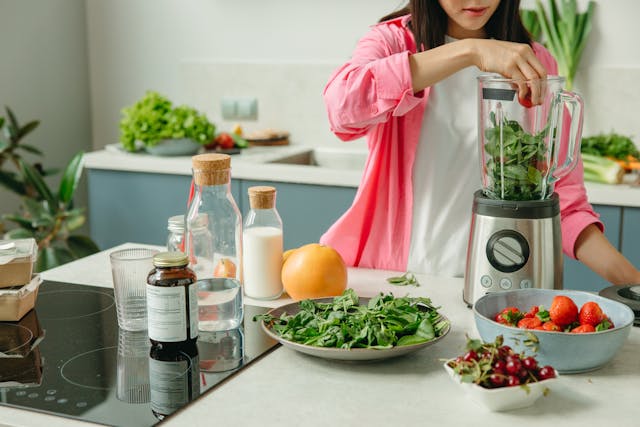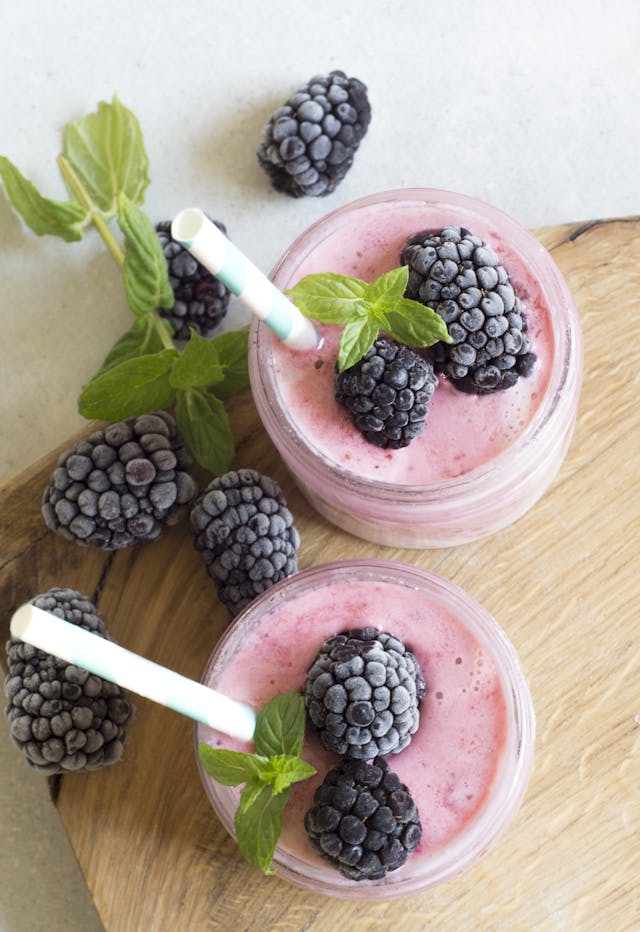Navigating the world of blending fruits and vegetables is akin to being an artist with a blank canvas; the possibilities are as limitless as your imagination. You’ve likely heard of classic combinations like strawberries and bananas, but have you ever considered the vibrant dance of flavors that a mix of kale and kiwi could bring to your palate?
Each blend not only tantalizes your taste buds but also packs a powerful punch of nutrients. Let’s explore how to pair these natural delights for the most tantalizing and healthful concoctions that could revolutionize your daily intake. What undiscovered pairings await to elevate your blending game?
Why Blend Fruits and Veggies
Blending fruits and veggies together offers a powerhouse of nutrition, combining essential vitamins, minerals, and phytonutrients that enhance your overall health. When you mix these natural ingredients into smoothies, you’re not just enjoying a refreshing drink; you’re taking a significant step towards a healthier lifestyle.
The beauty of these combinations lies in their complementary nutritional profiles, which work together to create a rich tapestry of health-promoting compounds. Each sip delivers a diverse array of nutrients crucial for your body’s well-being.
Nutrition and Flavor Benefits
When you blend fruits and vegetables together, you’re not just mixing flavors; you’re also combining powerful nutrients and antioxidants that can significantly boost your health. By exploring health-boosting combinations and flavor fusion tips, you’ll discover how sweet and bitter profiles can perfectly balance each other out. This exploration into antioxidant-rich pairings won’t only elevate your smoothie game but also enhance your daily nutrient intake.
Health Boosting Combinations
Discover how pairing certain fruits and vegetables can significantly enhance both your health and the flavor of your smoothies. When you mix watermelon and cucumber, you’re not just enjoying a refreshing drink; you’re also getting lycopene, vitamins A, C, K, magnesium, and silica, all crucial for hydration and nourishing your body.
Blending honeydew melon with celery introduces a power-packed dose of vitamin C, potassium, vitamin K, folate, and antioxidants, making for a revitalizing beverage. Pineapple and celery together create a tropical twist rich in bromelain enzymes, vitamin C, and hydrating electrolytes.
A dragonfruit and fennel smoothie offers a unique taste along with betalains, vitamin C, potassium, and fiber. Lastly, combining cherries and kale delivers a colorful mix full of anthocyanins, vitamin C, vitamins A, K, and sulforaphane, essential for a nutrient-rich boost.
Flavor Fusion Tips
Let’s explore how to perfectly balance taste and nutritional benefits by pairing the right fruits and vegetables in your smoothies. Here are some flavor fusion tips to help you get started:
- Sweet fruits like pineapple and honeydew melon blend well with Green Vegetables to Add such as celery and kale. This mix balances juicy sweetness with a slightly bitter edge, creating a delicious and nutritious smoothie.
- Experiment with unique fruit and vegetable pairings like dragonfruit with fennel or peaches with fennel for a refreshing taste and a boost of vitamins and fiber.
- For hydration and a plethora of nutrients, combining fruits and vegetables like watermelon and cucumber or pineapple and celery offers a perfect blend of lycopene, vitamins, and electrolytes.
Antioxidant-Rich Pairings
By blending antioxidant-rich fruits and vegetables like blackberries and beets, you’ll unlock a powerhouse of nutrition and flavor benefits in your smoothies. These antioxidant-rich pairings not only tantalize your taste buds but also provide a significant health boost. Here’s a breakdown of some top pairings:
| Pairing | Key Nutrients | Health Benefits |
|---|---|---|
| Blackberries + Beets | Vitamin C, Nitrates, Betalains, Anthocyanins | Supports heart health, reduces inflammation |
| Blackberries + Carrots | Vitamin A, Anthocyanins | Boosts immune system, promotes eye health |
| Strawberries + Beetroot | Vitamin C, Manganese, Antioxidants, Nitrates | Enhances cellular health, improves stamina |
Incorporating these combinations into your diet helps combat oxidative stress and promotes overall well-being.
Top 25 Smoothie Combinations
Diving into our list of top 25 smoothie combinations, you’ll find each pairing is uniquely crafted to boost your health with essential vitamins and minerals. These blends are perfect whether you’re at a juice bar and creating your own concoction or whipping up veggie smoothies at home. Understanding which fruit goes well with the best green vegetables can transform your smoothie from mundane to extraordinary.
- Fruit and Vegetable Combinations:
- Watermelon and cucumber aren’t just for salads; they make a hydrating smoothie base, rich in lycopene and vitamins.
- Dragonfruit and fennel offer a less common, but incredibly nutritious, blend that’s as unique as it’s tasty.
- Blackberries and beets create a vibrant smoothie, packed with vitamin C and anthocyanins.
Each of these combinations brings together the best fruits and vegetables for a powerhouse of nutrients. For example, the mango and spinach combo is an iron and antioxidant-rich blend, perfect for a morning boost or a post-workout refresh. Similarly, kiwis paired with zucchini make a vitamin C-rich smoothie that’s not only nutritious but also delicious. These best fruit combinations are designed to maximize the health benefits and flavor of your smoothie, ensuring you’re not only enjoying what you’re drinking but also nourishing your body with every sip.
Choosing the Right Produce
When you’re picking fruits and vegetables for your smoothies, it’s crucial to consider seasonal availability for the freshest options. You’ll also want to think about how the flavors and textures of different produce can complement each other. This ensures you’re not only getting the best taste but also a wide range of nutrients.
Seasonal Produce Selection
Selecting seasonal fruits and vegetables guarantees you’ll enjoy the freshest flavors and highest nutrient content available. When you choose seasonal produce for your fruits and veggies to blend, you’re not just making a green smoothie; you’re crafting a nutrient-rich experience. By focusing on nutrition and flavor, your fruit and veggie smoothie becomes more than just a drink—it’s a health boost.
Here’s why seasonal selections matter:
- Peak Freshness: Seasonal fruits and veggies are harvested at their prime, ensuring the best taste and highest vitamin levels.
- Support Local: Buying seasonal supports local farmers and cuts down on transportation, making it an eco-friendly choice.
- Cost-Effective: Abundance of produce means lower prices. Don’t forget, veggies like frozen cauliflower can also be a great, affordable option year-round.
Flavor Compatibility Considerations
After understanding the importance of choosing seasonal produce for their freshness and nutritional value, it’s crucial to consider flavor compatibility to create delicious and harmonious smoothies.
Sweet fruits like bananas and berries work wonders with bitter greens such as spinach and kale, balancing the flavors in your smoothie. If you’re aiming for a harmonious taste profile, acidic fruits like oranges and pineapples complement earthy vegetables like beets and carrots beautifully.
For a creamier texture, blend creamy fruits like avocado with crunchy veggies like celery. Tropical fruits, including mango and papaya, add a sweet, exotic twist to green smoothies with leafy choices like Swiss chard.
Lastly, citrus fruits like lemons and limes can brighten up your smoothie with a zesty kick when mixed with bold vegetables like ginger or turmeric.
Preparing Your Ingredients
Before blending your fruits and vegetables, it’s crucial to prepare them properly to ensure a smooth and safe consumption experience. When you’re ready to create that perfect smoothie, paying attention to how you prep your ingredients can make all the difference in the texture and overall quality of your blend.
Here’s how to get your fruits and veggies blender-ready:
- Wash Everything Thoroughly: Before they make their way into your blender, ensure all fruits and vegetables are washed well. This step removes dirt, pesticides, and harmful bacteria, safeguarding your health and enhancing the flavor of your smoothie.
- Peel, Pit, and Prep: For a smoother texture, peel fruits like oranges, kiwis, and bananas, and remove pits from cherries and peaches. Additionally, chopping larger fruits and vegetables into smaller pieces promotes even blending.
- Remove Unwanted Parts: Tough stems, seeds, and cores from produce like apples, pears, and pineapples should be discarded to prevent a gritty or fibrous consistency in your smoothie. Consider freezing fruits like berries and bananas for a thicker, colder drink without diluting it with ice.
Blending Techniques Explained
To achieve the perfect smoothie texture, mastering the art of blending your fruits and vegetables is essential. Here’s how you can use blending techniques to ensure smooth textures and balanced flavors in your creations.
First off, starting with liquid ingredients like water or fruit juice at the bottom of your blender makes the blending process smoother. Using a high-speed blender, such as a Vitamix, is highly recommended for the best results. This type of blender ensures that you won’t find unexpected vegetable chunks in your smoothie, giving you that smooth consistency you’re after.
Here’s a quick table to guide you through proper blending techniques:
| Step | Ingredient Type | Reason |
|---|---|---|
| 1 | Liquid ingredients | Facilitates blending |
| 2 | Vegetables | Ensures smooth consistency |
| 3 | Fruits | Adds natural sweetness |
| 4 | Ice or frozen ingredients | For chill and thickness |
| 5 | Blend on high-speed | For optimal smoothness |
Always blend your veggies first before adding fruits. This step is crucial for avoiding any fibrous bits and achieving a perfectly smooth drink. Remember, proper blending techniques are key to unlocking the full potential of your fruits and vegetables in a smoothie.
Smoothie Add-In Ideas
Adding nut butter, plain yogurt, or protein powder to your smoothie can significantly boost its nutritional value, ensuring you’re not just satisfied but also nourished. Nut butter introduces healthy fats and protein, making your drink more filling. Plain yogurt, meanwhile, not only ups the protein content but also lends a desirable creamy texture. And for those especially rigorous days, adding protein powder can be the perfect post-workout refuel.
For an even more nutrient-dense smoothie, consider these smoothie add-in ideas:
- Collagen Powder: Ideal for promoting skin, hair, and joint health, collagen powder seamlessly blends into your smoothie without altering the taste, enhancing the protein content further.
- Shelled Hemp Hearts: These tiny powerhouses pack in protein, healthy fats, and essential nutrients, contributing to both the nutritional value and the texture of your smoothie.
- High Water Content Vegetables: Believe it or not, adding vegetables with a high water content, like raw carrot, can’t only boost the nutritional profile but also enhance the smoothie’s texture. Just make sure you have a high-powered blender to handle the job.
Experimenting with these smoothie add-in ideas won’t only diversify your nutritional intake but also keep your taste buds guessing.
Recipe Inspirations
Let’s dive into some recipe inspirations that’ll transform your smoothie game with vibrant colors, essential nutrients, and delicious flavors. Imagine starting your day with a Beet Smoothie, blending strawberries and beets for a mix rich in vitamin C, antioxidants, and essential minerals. It’s one of the best fruit and vegetable combinations for delicious and nutritious morning kicks.
For a green power boost, try making smoothies with spinach, kale, and a touch of avocado. This Vegetable Smoothie packs in vitamins A, C, and K, plus the creaminess of the avocado elevates the texture to creamy perfection. If you’re after something to support your immune system, mix blackberries and carrots. This combo not only tastes great but also provides immune-boosting properties and anthocyanins.
For those who love to experiment, a Dragonfruit and Fennel Avocado Smoothie might just be your new favorite. It’s a unique blend offering betalains, vitamin C, and potassium. And for a classic, yet always satisfying choice, blend mango and spinach. This simple mix is bursting with vitamins, iron, and antioxidants, proving that making smoothies with the right fruit and vegetable combinations can be both easy and incredibly beneficial for your health.
Conclusion
So, you’ve got the scoop on blending fruits and veggies together. It’s all about packing in that nutrition while sipping on something delicious. Whether you’re tossing watermelon with cucumber or getting bold with blackberries and beets, there’s a combo out there for you. Remember to pick fresh produce, prep it right, and play around with blending techniques. Don’t forget to throw in some fun add-ins.
Ready to get creative? Dive into those recipes and whip up your next favorite smoothie. Cheers to health and flavor!






